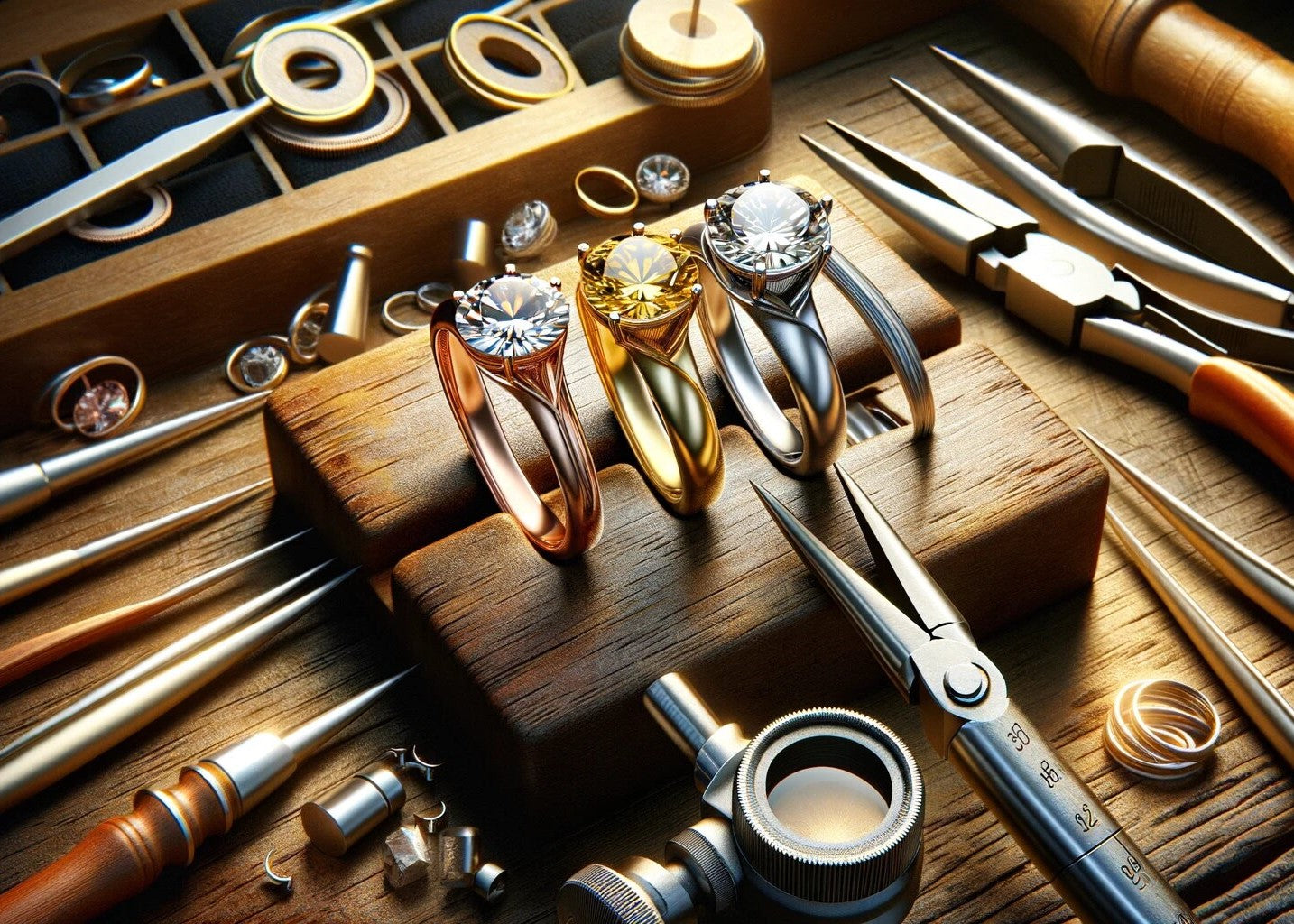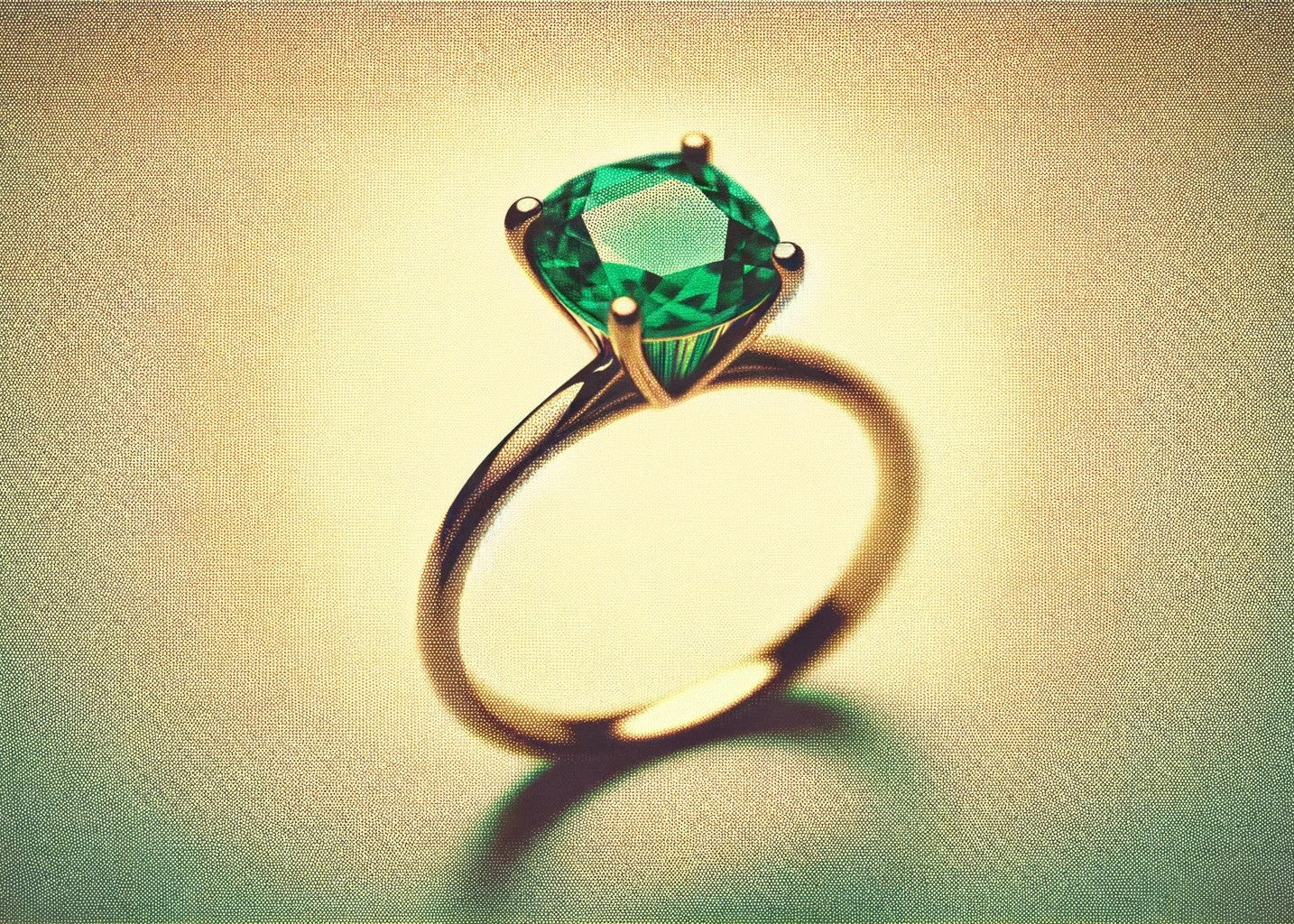Yellow Gold
Yellow gold has this classic vibe that's hard to beat, especially when you're thinking about something as special as an engagement ring. It's like the gold standard of golds—literally!
Made by mixing pure gold with metals like copper and silver, it gets that warm, inviting colour that can look good on just about anyone. Plus, it's kind of neat to think about wearing something made from the same material that people have been treasuring for centuries.
But let's be real, while it's beautiful and all, yellow gold isn't perfect. It's softer than some other metals, so if you're someone who's tough on your jewellery, you might find yourself with a few scratches here and there. And even though it's pretty low maintenance, you'll want to give it a polish now and then to keep it looking its best.
Choosing yellow gold for an engagement ring feels like connecting to a long line of tradition. It's got a warmth that just seems to say "forever." But, you've got to think about the practical side too. It's awesome that it's so moldable—great for custom designs and if you ever need to resize it.
The price is pretty reasonable too since the value comes from the gold content, so you're not just paying for a look but for something that actually holds its worth. Just remember, it's not just about picking a ring; it's about choosing something that'll be a part of your daily life.
So, if you're okay with giving it a little TLC now and then, and you're all about that timeless charm, yellow gold could be the way to go for that forever ring.

Blue Sapphire and Diamond Twist Ring by Natalia Rafi
White Gold
White gold is like the cool, modern cousin in the gold family, giving you that sleek, shiny look that's super versatile. It's made by mixing pure gold with other white metals like nickel or palladium, and then it gets this shiny coat of rhodium to give it a really bright, white finish.
This makes it tougher and a bit more resistant to scratches compared to yellow gold, which is great if you're a bit clumsy with your jewellery or you wear it every day. Plus, it's got this modern vibe that works well whether you're going for a minimalist look or something more flashy.
But, just like anything else, white gold isn't perfect. That shiny rhodium plating? It doesn't stick around forever. Over time, it can wear off, and you might need to get your ring re-plated to keep it looking its best. And, if you're someone with sensitive skin, you'll want to double-check what metals are mixed in there because white gold often contains nickel, which can be a no-go for some folks.
Also, if down the line you need to resize your ring, white gold can be a bit trickier to work with because of that rhodium plating.
So, when you're thinking about an engagement ring and considering white gold, it's all about what vibes with you. If you love the idea of a metal that's got a bit of a modern edge, can stand up to a bit of wear and tear, and you're okay with a little maintenance now and then, white gold could be your match.
Just remember to think about those little quirks like the rhodium plating and the potential for nickel sensitivity.

Rosalia 1ct - Blue Green Sapphire Engagement Ring by Kiya Corrales
Rose Gold
Rose gold is like that unique twist on something classic; it's got this cool mix of vintage charm and modern flair that's been catching everyone's eye lately. This pretty metal is gold mixed with copper to give it that lovely pinkish colour.
The more copper, the redder the gold. It's got this whole warm, romantic vibe going on that makes it a hot pick for anything from engagement rings to your everyday jewellery.
But, as with everything, rose gold has its quirks. While it's pretty durable and doesn't tarnish easily, it's not the most common gold out there. So, if you're hunting for that perfect piece, you might find it's a bit harder to come by, or maybe a tad pricier, due to its rarity.
Also, if you've got super sensitive skin, the copper in rose gold might not be your best friend. And, though it's got that timeless appeal, its distinct colour might not jive with every piece in your jewellery box, especially if you're mixing and matching different types of gold.
Choosing rose gold for an engagement ring or any piece of jewellery is kinda like saying, "I'm all about that blend of tradition and trend." It's for someone who's looking to stand out a bit, but still keep things classy.
Just remember, its unique colour and composition mean it might need a bit more thought when pairing it with other pieces, and maybe a bit more care to keep it looking fresh.
TAVY Engagement Ring by Molten
A Handy Summary
| Type of Gold | Composition | Pros | Cons | Best For |
|---|---|---|---|---|
| Yellow Gold | Pure gold mixed with metals like copper and silver | Timeless appeal, hypoallergenic, versatile, retains value | Prone to scratches, requires regular cleaning, potential for allergic reactions to alloys | Classic and timeless designs, suits all skin tones, especially olive and darker tones |
| White Gold | Pure gold mixed with white metals like nickel or palladium, coated with rhodium | Durable, modern look, versatile, relatively affordable | Rhodium plating wears off, potential nickel allergy, requires re-plating, trickier to resize | Modern and minimalist designs, good for those preferring a sleek look |
| Rose Gold | Gold mixed with a higher copper content, giving it a pinkish hue | Unique colour, vintage charm, romantic appeal, durable due to copper content | Limited availability, potential for copper allergies, may not match other jewellery, can fade over time | Vintage and bohemian-inspired designs, suits warm skin tones |
What is Gold Plated Jewellery?
Plated gold is essentially a thin layer of gold that's applied over another metal, such as copper or silver, through a process called electroplating. It's like giving a piece of jewellery a gold makeover to give it that shiny, gold appearance without the whole piece being made of solid gold.
This method is a cost-effective way to get the look and feel of gold, without the higher price tag that comes with a solid gold item.
The key difference between plated gold and solid gold lies in their composition and durability. Solid gold is just that—solid. The entire piece of jewellery is made of gold, although often mixed with other metals to increase its strength, since pure gold is quite soft. The karat number tells you how much gold is in the piece, with 24 karat being pure gold.
On the other hand, with plated gold, only the outer layer is gold, and it's usually a very thin layer at that. This means that over time, with wear and tear, the gold layer can wear off, revealing the metal underneath.
So, while plated gold items can look just as shiny and beautiful as solid gold at first glance, they may not hold up as well over time and with frequent wear.
Plated gold is great for fashion jewellery that you might not wear every day, but for pieces like engagement rings or other significant items that you plan to wear often, solid gold might be a better choice for its longevity and durability.
FAQ's
Which is better: white, yellow, or rose gold?
There isn't a definitive answer to this as it depends on individual taste, skin tone, and the specific use of the jewellery. White gold offers a modern and sleek look, yellow gold is classic and timeless, and rose gold provides a unique, vintage appeal. Each has its own pros and cons, so the best choice is the one that aligns with your personal style and needs.
Which colour gold is most expensive?
The price of gold jewellery depends more on the purity (karat) of the gold used rather than its colour. All things being equal (karat weight, design complexity, brand, etc.), white, yellow, and rose gold pieces of the same karat weight are generally similar in price. However, white gold may occasionally be slightly more expensive due to the rhodium plating process it undergoes to enhance its white appearance.
Does rose gold or white gold last longer?
In terms of durability, rose gold is often considered more durable than white gold due to the copper content in rose gold, which strengthens the alloy. White gold is usually coated with a layer of rhodium for a bright white finish, which can wear off over time and require re-plating. Rose gold's durability, combined with its natural colour (which doesn't require additional plating), can make it last longer in terms of maintaining its original appearance without the need for as much maintenance.
Who should wear rose gold?
Rose gold is versatile and complements a wide range of skin tones, making it a suitable choice for many people. Its warm, pinkish hue looks particularly flattering on individuals with cooler skin tones, adding a soft glow. However, its unique colour also makes it a popular choice for those looking to make a fashion statement or who prefer jewellery with a romantic or vintage aesthetic.
What colour gold is most popular?
The popularity of gold colours can vary based on fashion trends, cultural preferences, and individual taste. Currently, white gold is very popular for engagement rings and wedding bands due to its modern appearance and similarity to platinum. However, yellow gold has been regaining popularity for its classic and warm look, and rose gold continues to be a favorite for its unique and romantic appeal. The most popular choice varies over time and among different demographics.






